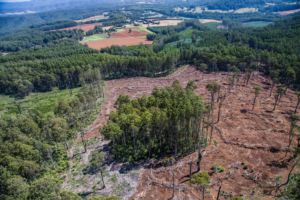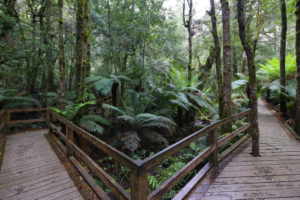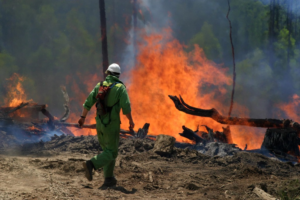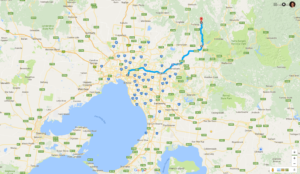Itinerary
| 7:45am | Meet outside Gate 3 at the Melbourne Cricket Ground (MCG) |
| 8:00am | Depart MCG via coach and travel to Healesville |
| 9:15am | Arrive Healsesville for a rest stop |
| 9:30am | Depart Healseville for Sylvia Creek |
| 10:00am | Forest Stop 1 and morning tea at Sylvia Creek Road |
| 10:45am | Depart Sylvia Creek for Forest Stop 2 |
| 11:00am | Arrive at Forest Stop 2 – Rusty and Skinny Jim Coupes |
| 11:45am | Depart for Wirra Willa Rainforest Walk |
| 12:00pm | Arrive at Forest Stop 3 – Wirra Willa Rainforest Walk, lunch |
| 1:00pm | Depart Wirra Willa Rainforest Walk |
| 1:15pm | Arrive at Forest Stop 4 -The Kalatha Giant (Time and weather dependent) |
| 2:00pm | Depart for Healesville |
| 2:30pm | Arrive at Healesville for a rest stop |
| 4:30pm | Arrive at Melbourne Cricket Ground (MCG) |
Introduction
VicForests offers a warm welcome to the INI2016 delegates to the forests around Toolangi.
This beautiful area provides a great example of forest management in Victoria and a fantastic illustration of our sustainable timber industry.
The tour will visit forest which is managed in many different ways including forest which is protected for its environmental values, forest available for timber harvesting, forest recently harvested and forest which is growing back after previous harvesting operations.
The tour will also cover how management of these forests is integrated into the management of neighbouring areas for agriculture, domestic and rural water supply, tourism and conservation.
History of timber harvesting in Toolangi’s Forests
The forests in and around Toolangi have a long history within the forestry industry, where timber harvesting has been taking place for more than a century.
Evidence of past timber cutters is scattered through the forest. Trees and remnants of tramways can be found.
Mountain Ash trees dominate the forest here and are the tallest flowering plant in the world, some reaching up to 100 metres in height.
The timber found in the Toolangi forests is some of the most beautiful and sought after in the world and can be used for a variety of purposes. Sawn timber produced from these trees is used to make prestige furniture and flooring.
Wild fires in 1939 had a huge impact across the Central Highlands region and most of the trees that are harvested for sawlogs are trees that have regrown since those fires.
Forest Stop 1 - Sylvia Creek Road
FOREST STOP 1 – Sylvia Creek Road
Regrowing forest, landscape and land use interfaces
This site provides an excellent opportunity to observe and understand the interface between agricultural land / forest / national park and the significance of high rainfall / soil fertility / catchments
Land use in this region includes horticulture (e.g. strawberry farms), and forestry. Many of the water catchments supply the nearby Sugarloaf, Maroondah, Oshannassy, Upper Yarra and Silvan water supply reservoirs for Melbourne. The northern catchment forms part of the Goulburn River catchment which supply Victoria’s food bowl through the Goulburn Murray Irrigation District.
Almost the first thing you see on the left hand side of Sylvia Creek Road is an area of forest which has been re-growing since a harvesting operation there in 2007/8.

Forest Stop 2 - Rusty and Skinny Jim Coupes
FOREST STOP 2 – Rusty and Skinny Jim Coupes
Rusty Coupe – (Right hand or uphill side of Sylvia Creek Road)
This coupe (a coupe is a forestry term for a timber harvesting area) was harvested using the retention harvesting method adopted by VicForests in the Leadbeater’s Possum range.
More than 10 hectares of forest directly adjacent or within the coupe has been retained and protected by VicForests to protect environmental values. The majority of large, hollow bearing mixed species trees have been excluded from harvesting including a group of large trees incorporated into a one hectare retained ‘island’.
The Australian National University’s flora and fauna monitoring site is also protected by a 50 metre buffer. Following consultation with the community, an additional buffer has been added to provide a corridor between the forest and the area being harvested.

Leadbeater’s Possum
The Leadbeater’s Possum is the Victorian State emblem and was recently listed as Critically Endangered by the Federal Minister for Environment due to the reduction in its population and available habitat: hollow bearing trees and understorey structure, particularly following the 2009 Black Saturday fires. This native marsupial a charismatic shy species, is nocturnal, and nests in 150+ year old trees with natural hollows.
The Leadbeater’s Possum is described as grey to greyish brown at the top with a distinguishable dark mid-dorsal stripe, pale cream underside and club-shaped tail that is broader at the tip. The Possum moves quickly through the forest leaping from one tree to the next, which can making them difficult to observe.
The preferred habitat of Leadbeater’s Possum includes Ash forests that contain both wattles as a food source and an ample supply of old, hollow-bearing trees for their nesting (Macfarlane et al. 1997). As this species does not have a gliding membrane, another important habitat requirement for this species is dense surrounding vegetation to allow them to move through the forest.
More than 30,000 hectares of Ash-eucalypt forest is reserved in the Central Highlands specifically to protect the Leadbeater’s Possum population. All of the best known areas of Leadbeater’s Possum habitat not already reserved were included in an expansion to this reserve system during 2008. In addition to this, VicForests takes a range of measures to protect the Leadbeater’s Possum habitat from any possible disturbance caused by timber harvesting outside the reserves.
An area of 60 year old regrowth forest can be seen on the downhill side of Dunstan’s track. This stand has a well-developed understorey with tree ferns, musk daisy bush, silver wattle and a range of other species. There are also some older trees that originated from the 1926 and 1939 fires. Messmate and Grey Gum are interspersed throughout the Mountain Ash.

Regrowth Retention Harvesting
Harvesting by this method retains additional areas for a range of benefits including protection of species habitat, promoting the development of older forest structures and improving habitat connectivity.
It is an alternative to traditional clearfell harvesting methods and aims to protect biodiversity values while still allowing timber production.
VicForests is using retention harvesting to ensure older forest elements are retained and can develop in areas available for timber harvesting.
These mature and older forests provide specific habitat values for a range of species found in our forests where the amount of older forest in Victoria is significantly affected by our history of bushfire.
Retention harvesting is designed to work in conjunction with Victoria’s extensive National Park and reserve system to promote older forest, and habitat connectivity across the landscape, and will replace traditional clearfell harvesting methods in 50% of the area harvested across the Leadbeater’s Possum range.
Skinny Jim Coupe
This site provides an opportunity to investigate the role of nitrogen in forest management particularly as it relates to forest disturbance through timber harvesting activities, planned burning and wild fire.
This coupe was harvested in 2015 then was prepared for regeneration by burning in March 2015, followed by sowing in April 2016 with Mountain Ash (Eucalyptus regnans) seed collected locally by VicForests.
Regrowing our forests
Regrowing our forests after harvesting is a vital component of our operations. VicForests regrows forests on every harvested area to ensure the forest returns to maturity and is left to grow to be they enjoyed by future generations of the public and sustainably managed by the forest management leaders of tomorrow.
The regeneration of our forests is a detailed process which can take more than three years to complete successfully, before allowing the natural growth stage to continue with no further monitoring.
All coupes are sown with seed that is collected in the same vicinity as the harvested coupe and in proportion to the original species mix that was there prior to harvesting.
Each year VicForests collects Eucalyptus seed, which is placed into storage for future regeneration programs.
Over the past five years, this seed in storage has also been used to grow over 8,300 hectares of native forest that was killed by severe bushfire.
Forest Stop 3 - Wirra Willa
FOREST STOP 3 – Wirra Willa
Cool Temperate Rainforest walk and Lunch stop
The rainforest walk sits within a Special Protection Zone in the State forest. If you are interested in this walk, it is approximately a 1km loop and should take about 45 minutes.

Special Protection Zones
Special Protection Zones are formally protected areas within the State forest that are protected from timber harvesting for a range of special biodiversity values such as Leadbeater’s Possum habitat or temperate rainforest ecosystems.
These areas work in conjunction with Victoria’s National Park and reserve system to provide an additional level of protection for important environmental values.
There a number of other examples of Special Protection Zones in place through the Toolangi State forest as well as the Yarra Ranges National Park which covers 77,000 hectares to the south.
Hundreds of new Leadbeater’s Possum colonies discovered
There have been 316 new Possum colonies verified since February 2015 following surveys conducted by the Department of Environment, Land, Water and Planning, Arthur Rylah Institute (ARI), VicForests, Parks Victoria, Zoos Victoria and the community, including four detections verified in the past week.
VicForests’ General Manager, Planning, Nathan Trushell said “When a colony is detected in forest available for timber harvesting, the site is protected through the application of a 12 hectare timber harvesting exclusion zone.
Mr Trushell said some Leadbeater’s Possum colonies were detected in areas regrowing after being harvested in the 1980s and 1990s. “This is a ground-breaking discovery because it had been unclear how quickly the Possum would use a site after timber harvesting takes place..
“These detections occurred in areas that were harvested just 20 or 30 years ago with the regrowing forest seemingly providing an excellent food source for the Possum,” he said.
Leadbeater’s Possums were also found living in tree hollows artificially created as part of a collaborative project between ARI and VicForests designed to provide additional habitat for the species while the forest grows old enough to form natural hollows. Possums have also been found using nest boxes.
Forest Stop 4 - Kalantha Giant
FOREST STOP 4 – Kalatha Giant
Old-growth Mountain Ash (Eucalyptus regnans)
The Kalatha Giant is the seventh largest tree in Victoria, with a girth of 13.85 metres and a height of 65.5 metres. It is found by turning left onto Kalatha Road and travelling for 800 metres. Stairs will be on the right and there is space on the road to pull vehicles off to the left.
This great tree is protected in a Special Protection Zone. It’s not just trees like the Kalatha Giant which are protected. All Ash trees originating from before 1900 are excluded from timber harvesting operations to provide habitat for native fauna.

Other Points of Interest
Fire
In addition to VicForests’ primary role of forest management – harvesting and regenerating allocated areas of Victorian native forest – many VicForests staff are trained firefighters or play other support roles fire management across the State.
The fire roles undertaken include operational fire-fighting, incident management and support roles such as logistics and information, and plant and aircraft support.
In addition to this VicForests’ contractors regularly provide heavy machinery equipment such as bulldozers and excavators which are essential to creating fire breaks during the fire season.
VicForests is part of the Networked Emergency Organisation (NEO) which also includes the Department of Environment, Land, Water and Planning (DELWP), Parks Victoria and Melbourne Water.
The NEO provides over 2,500 full time staff for fire roles and about 700 seasonal firefighters during summer months.
As well as contributing to wildfire suppression, VicForests also support DELWP with fuel reduction burns throughout the year, with the aim of reducing fuel loads to reduce wildfire intensity.

VicForests quick facts
- Victorian hardwood timber is used to make beautiful furniture and flooring as well as building materials and paper products.
- VicForests regrows every area of forest it harvests.
- VicForests has generated more than $1 billion in revenue over the last 10 years with almost all of this money going back into local, regional economies.
- VicForests is part of the Victorian timber industry which directly employs more than 21,000 people.
- VicForests is part of the communities within which it works. As well as sponsorship’s, financial support and in-kind donations, VicForests also runs a yearly Community Support Program that awards grants to groups and services that work to support their communities.
- Over the last five years, VicForests has awarded more than $260,000 to community groups and services through the Community Support Program.
Links for further reading:
www.vicforests.com.au/leadbeaters
http://www.vicforests.com.au/regeneration
http://www.vicforests.com.au/planning-2
http://www.vicforests.com.au/certification-and-scrutiny
http://www.vicforests.com.au/fire-protection
http://www.vicforests.com.au/supporting-local-communities
SAFETY
VicForests recognises its Health & Safety obligations and is committed to providing a safe and healthy working environment for its employees, contractors, suppliers, customers and other visitors who may enter a VicForests work area.
Instructions given by VicForests staff in relation to safety, environmental or social issues in the forest environment must be followed at all times.
Please note:
- A hard hat is mandatory in the forest environment and must be worn at all times. ( hard hat will be supplied)
- A fluorescent vest is required in an operational coupes and must be worn at all times. ( vest will be supplied)
- Sturdy footwear must be worn at all times
- Where practical avoid walking under trees containing dead limbs.
- Where practical do not walk within 2 tree lengths (particularly downhill) of dead trees.
- Burnt forest stands may have large numbers of dead trees and limbs.
- The ground in forest environments is often rough, steep and contains many trip / slip hazards.
If you become aware of an incident or accident, or hazard that may harm someone, please report it to an available VicForests officer or INI2016 representative as soon possible.
This tour is in a mountainous area where weather can rapidly change. Wear sun screen and preferably long sleeved shirts and pants and sunglasses in addition to the supplied hard hat and vest. Please have available waterproof and warm clothing in case of inclement weather. Please drink water regularly to remain hydrated.



